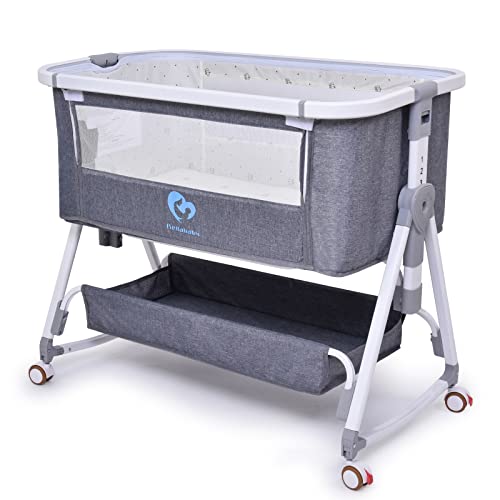The Benefits and Considerations of Bedside Co-Sleeping Cribs
As parents browse the early months of their kid's life, guaranteeing a safe and comfortable sleeping plan is typically at the leading edge of their minds. Among the numerous options available, bedside co-sleeping cribs have gained appeal for their inherent blend of availability and security. This article looks into what bedside co-sleeping cribs are, their advantages, factors to consider for selecting one, and answers to regularly asked concerns.
What Is a Bedside Co-Sleeping Crib?
A bedside co-sleeping crib is a sleeping space created to be connected to an adult bed, supplying an appropriate and safe environment for infants. These cribs typically feature adjustable heights and secure accessories that permit parents to quickly reach their sleeping baby while also guaranteeing that the baby has their independent sleeping space.
Provided the growing conversation around the benefits and threats of co-sleeping, these specially developed cribs intend to strike a balance between keeping the baby close for comfort and guaranteeing their safety.
Benefits of Bedside Co-Sleeping Cribs
Increased Convenience
- Bedside co-sleeping cribs enable parents to be close to their baby throughout the night. Bedside Cot For Safe Sleeping is particularly useful for breastfeeding moms, who can feed and comfort their kid without leaving their bed.
Safety Features
- The majority of co-sleeping cribs come equipped with functions such as safe and secure accessories, breathable mesh sides, and sturdy frames. These safety aspects assist to avoid unintentional suffocation or rolling over onto the baby.
Promotes Bonding
- The nearness of a co-sleeping arrangement may cultivate a stronger emotional bond in between parent and child, improving feelings of security and comfort for both celebrations.
Relieve of Monitoring
- Parents can easily monitor their infant during sleep, resulting in reduced stress and anxiety and offering assurance.
Motivates Healthy Sleep Habits
- Research study recommends that co-sleeping can encourage babies to develop self-soothing abilities, causing enhanced sleep patterns in time.
| Advantages | Information |
|---|---|
| Increased Convenience | Easy access for feeding and convenience throughout the night |
| Security Features | Strong accessories and breathable materials |
| Promotes Bonding | Closeness boosts emotional connection |
| Relieve of Monitoring | Parents can keep a watchful eye on their baby |
| Motivates Healthy Sleep Habits | Helps infants discover to self-soothe |
Considerations When Choosing a Bedside Co-Sleeping Crib
When picking a bedside co-sleeping crib, parents should remember a number of factors:
Safety Standards
- Ensure that the crib meets present safety requirements set by regulative bodies. Search for accreditations and safety scores.
Size and Adjustability
- Consider the size of the crib and whether it can get used to the height of your bed. An ideal crib should fit snugly versus the adult bed.
Ease of Use
- Take a look at features such as removable sides, collapsible frames, and ease of assembly and disassembly.
Product Quality
- Purchase cribs made from non-toxic, high-quality products that promote durability and safety for long-lasting use.
Visual Compatibility
- While performance is essential, it's also vital that the crib complements the bed room design.
Top Bedside Co-Sleeping Cribs in 2023
| Crib Model | Features | Rate Range |
|---|---|---|
| Chicco Next2Me | Adjustable height, breathable mesh sides, easy folding | ₤ 200 - ₤ 300 |
| Baby Delight Snuggle Nest | Removable side, portable, includes a nightlight | ₤ 150 - ₤ 250 |
| HALO Bassinest | Turns 360 degrees, adjustable, consists of calming sounds | ₤ 250 - ₤ 400 |
| Lully Sleep Nest | Convertible design, detachable mattress, environment-friendly products | ₤ 180 - ₤ 280 |
Frequently Asked Questions About Bedside Co-Sleeping Cribs
Q1: At what age is it safe to use a bedside co-sleeping crib?A: Bedside co-sleeping cribs are generally safe for infants from birth till they can pull themselves up, which is usually around 6 months of age. Always consult with your pediatrician for tailored guidance.
Q2: Are bedside co-sleeping cribs much better than standard cribs?A: This can depend on individual preference and lifestyle. Bedside co-sleeping cribs provide immediate accessibility while preserving a different sleep space for the infant. Standard cribs, while also safe, need parents to get up to take care of the baby.
Q3: Can I use bedding in a bedside co-sleeping crib?A: It is usually suggested to keep bed linen very little. A fitted crib sheet suffices to avoid suffocation dangers. Bonus blankets, pillows, and toys ought to be avoided.
Q4: Do I need to find special bed linen for a co-sleeping crib?A: Most co-sleeping cribs use standard crib-sized mattresses, so discovering bedding must not be a difficulty. Constantly confirm specs before acquiring.
Q5: Can a bedside crib avoid SIDS?A: While bedside co-sleeping cribs are developed to boost security, they do not guarantee security against Sudden Infant Death Syndrome (SIDS). To lower SIDS threats, follow safe sleep guidelines: location the baby on their back, make sure a firm bed mattress, and avoid sleep on soft surfaces.
Bedside co-sleeping cribs function as a functional compromise in between co-sleeping and guaranteeing an infant's security. They supply exceptional convenience while protecting the stability of independent sleep. However, potential purchasers must carefully consider their alternatives based on safety, size, and use requirements. As constantly, parents are motivated to seek advice from doctor when making decisions about their kid's sleeping arrangements.
In conclusion, a bedside co-sleeping crib might be an important addition to any parenting journey, mixing security with proximity to produce a nurturing sleep environment.

